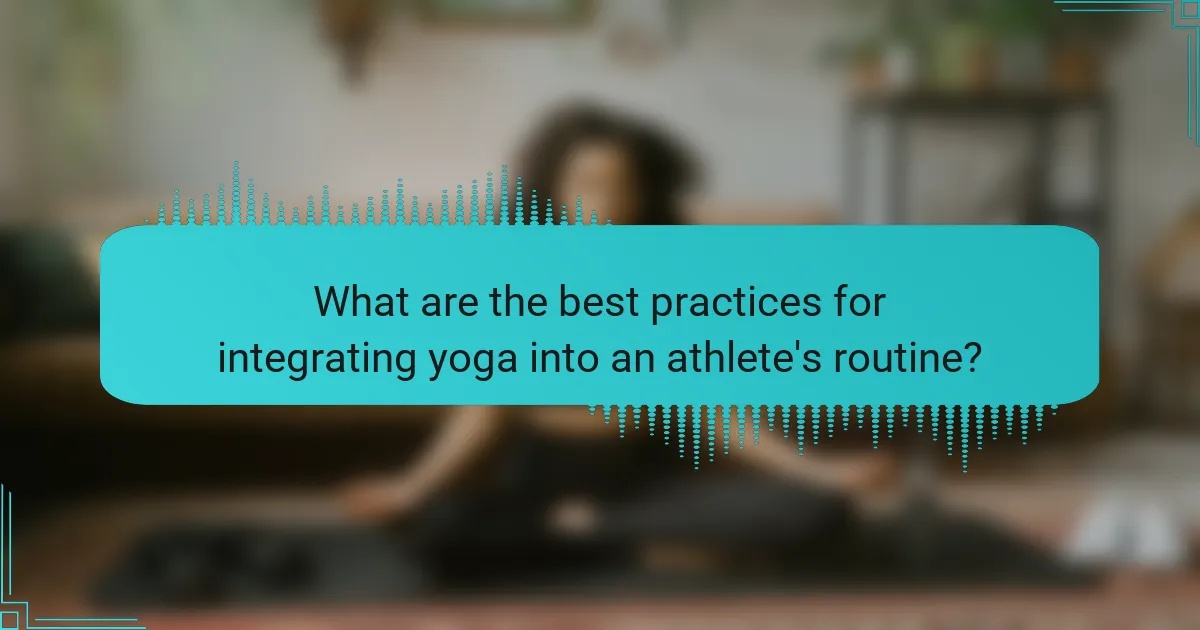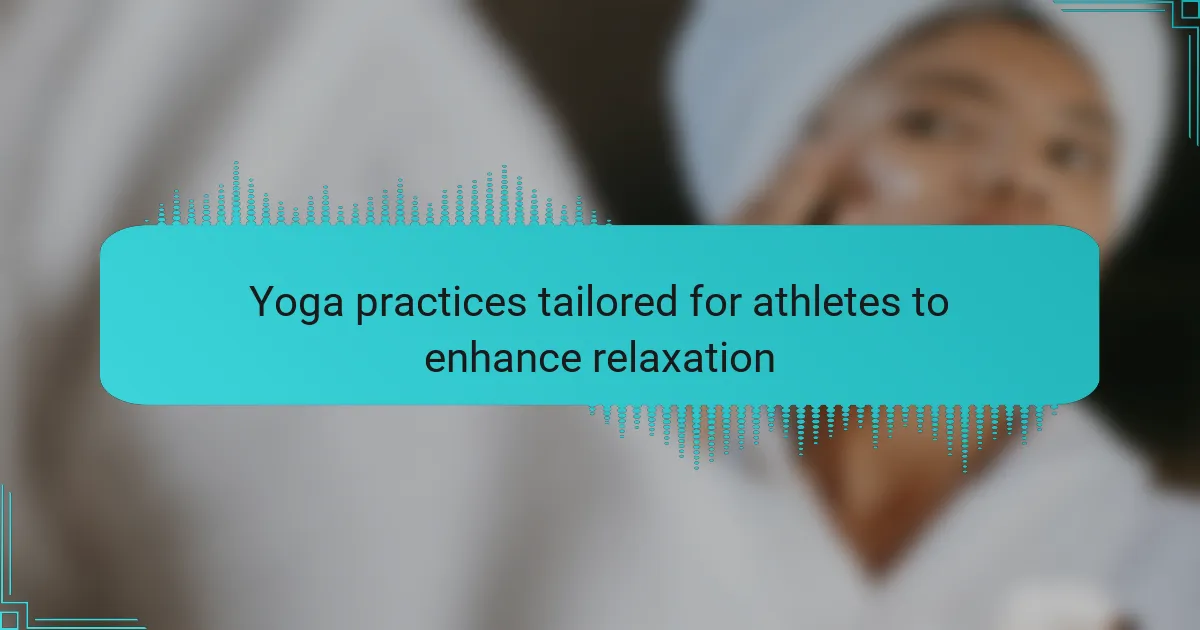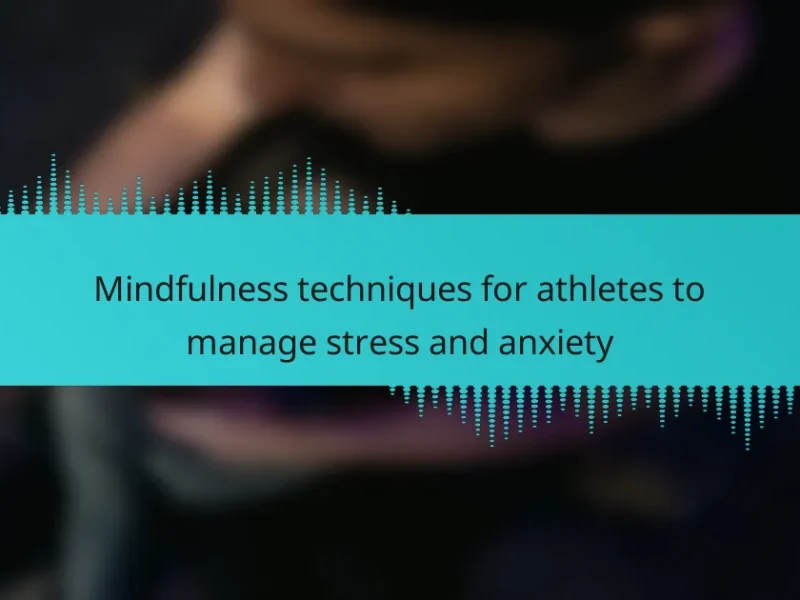Yoga practices can significantly enhance relaxation for athletes by promoting recovery and reducing stress. These techniques focus on flexibility, breath control, and mental clarity. Specific styles like Yin and Restorative Yoga aid in deep relaxation and muscle recovery. Incorporating these practices into training regimens can lead to improved performance and reduced injury risk.

What are the benefits of yoga practices for athletes?
Yoga practices enhance relaxation for athletes by promoting physical recovery, mental clarity, and emotional balance. These practices improve flexibility, reduce muscle tension, and enhance overall performance. Athletes often experience stress and fatigue, and yoga offers techniques to manage these challenges effectively.
Research indicates that regular yoga sessions can lead to a significant decrease in cortisol levels, contributing to lower stress and anxiety. Additionally, the mindfulness aspect of yoga helps athletes focus better during training and competition.
Unique attributes of yoga for athletes include specialized poses that target specific muscle groups used in various sports. For example, poses like Downward Dog and Pigeon are beneficial for athletes in endurance sports, enhancing both flexibility and strength.
Incorporating yoga into training regimens can lead to improved recovery times and reduced risk of injury. As a result, athletes who practice yoga often report enhanced performance and greater enjoyment of their sport.
How does yoga enhance physical recovery?
Yoga enhances physical recovery by promoting relaxation, reducing muscle tension, and improving circulation. These effects lead to faster healing and better overall performance for athletes. Specific practices like restorative yoga and breath control techniques are particularly beneficial. Research indicates that regular yoga can lower cortisol levels, aiding in stress management and recovery time. Additionally, yoga’s focus on flexibility helps prevent injuries, making it an essential component of an athlete’s training regimen.
What role does yoga play in mental relaxation for athletes?
Yoga plays a crucial role in mental relaxation for athletes by enhancing focus and reducing stress. Specific practices, such as deep breathing and mindfulness, help athletes manage anxiety and improve performance. Research indicates that regular yoga practice can lower cortisol levels, promoting a state of calm. Athletes often report improved mental clarity and emotional resilience, which are vital during competition. Incorporating yoga into training routines fosters a balanced mindset, ultimately benefiting overall athletic performance.
How can yoga improve flexibility and performance?
Yoga significantly enhances flexibility and performance for athletes by promoting relaxation and muscle elasticity. Regular yoga practice increases joint range of motion, reduces muscle tension, and improves overall body awareness. Specific poses target muscles used in athletic activities, leading to better movement efficiency. As a result, athletes experience reduced risk of injury and improved recovery times.

What unique yoga practices are tailored for athletes?
Yoga practices tailored for athletes enhance relaxation through targeted techniques. These practices focus on flexibility, breath control, and mental clarity, crucial for athletic performance.
One unique practice is Yin Yoga, which promotes deep stretching and relaxation, helping athletes recover from intense workouts. Another effective approach is Restorative Yoga, using props for support to facilitate relaxation and reduce tension.
Athletes may also benefit from Vinyasa Yoga, which links breath with movement, enhancing focus and stamina. Integrating these practices into training regimens can lead to improved performance and reduced injury risk.
Incorporating yoga into an athlete’s routine fosters both physical and mental resilience, essential for peak performance.
Which specific poses are most effective for athletic relaxation?
Yoga poses such as Child’s Pose, Legs-Up-The-Wall Pose, and Savasana are highly effective for athletic relaxation. These poses promote deep breathing, reduce muscle tension, and enhance mental clarity.
Child’s Pose stretches the back and hips, providing a calming effect. Legs-Up-The-Wall Pose encourages circulation and relieves tired legs. Savasana allows complete relaxation, aiding recovery after intense workouts.
Incorporating these poses into a routine can significantly improve relaxation and overall athletic performance.
How to perform the Supta Baddha Konasana for relaxation?
To perform the Supta Baddha Konasana for relaxation, follow these steps:
1. Sit on the floor with your legs extended.
2. Bend your knees, bringing the soles of your feet together.
3. Allow your knees to fall open to the sides.
4. Lie back gently, using a bolster or cushion for support if needed.
5. Relax your arms by your sides, palms facing up.
6. Breathe deeply, focusing on releasing tension.
This pose enhances relaxation by promoting deep breathing and opening the hips. It is particularly beneficial for athletes to alleviate stress and improve flexibility.
What is the role of Viparita Karani in post-workout recovery?
Viparita Karani aids post-workout recovery by promoting relaxation and reducing muscle tension. This restorative pose enhances blood circulation, allowing oxygen and nutrients to reach fatigued muscles. Additionally, it activates the parasympathetic nervous system, facilitating stress relief and mental clarity. Athletes benefit from improved flexibility and reduced recovery time, making it a valuable addition to their routine.
Are there specialized yoga classes for athletes?
Yes, specialized yoga classes for athletes exist to enhance relaxation and performance. These classes focus on techniques that improve flexibility, strength, and mental clarity. Unique attributes include tailored sequences designed for specific sports, addressing athletes’ needs. For example, classes may incorporate breath control and restorative poses to aid recovery. As a result, athletes experience reduced stress and improved focus, which positively impacts their overall performance.

What are the rare attributes of yoga practices for athletes?
Yoga practices for athletes can enhance relaxation through unique attributes like breath control techniques, which promote deeper relaxation. Another rare attribute is the integration of mental visualization exercises that improve focus and recovery. Additionally, some yoga styles incorporate sport-specific poses that address muscle imbalances, fostering better overall performance. These rare elements contribute to a holistic approach in yoga tailored specifically for athletic needs.
How can yoga be adapted for different sports?
Yoga can be effectively adapted for different sports to enhance relaxation and performance. Tailored practices focus on specific physical demands and mental challenges of each sport.
For example, runners benefit from hip-opening poses to improve flexibility, while weightlifters may focus on core-strengthening postures to enhance stability. Athletes in sports like soccer can use yoga to improve balance and coordination through dynamic movements.
Incorporating breath work into these sessions helps athletes manage stress and maintain focus during competitions. Consistent practice fosters a greater mind-body connection, leading to improved overall athletic performance.
Ultimately, adapting yoga to specific sports creates a personalized approach, enhancing relaxation and recovery while addressing unique physical needs.
What unique breathing techniques are beneficial for athletes?
Unique breathing techniques beneficial for athletes include diaphragmatic breathing, box breathing, and alternate nostril breathing. These techniques enhance relaxation, improve oxygen delivery, and reduce stress levels. Diaphragmatic breathing engages the diaphragm, promoting deeper breaths and better lung capacity. Box breathing, characterized by equal inhalation, retention, exhalation, and retention durations, helps regulate heart rate and improve focus. Alternate nostril breathing balances the body’s energy and calms the mind, making it ideal for pre-competition preparation. Each technique can be integrated into an athlete’s routine for optimal performance.

How do regional practices influence yoga for athletes?
Regional practices significantly shape yoga for athletes, enhancing relaxation techniques. Different cultures integrate unique attributes into their yoga practices, influencing athletes’ recovery and performance. For example, Indian yoga emphasizes breath control, while Japanese practices may focus on mindfulness. These variations provide athletes with diverse methods to reduce stress and improve focus. Tailored yoga routines can enhance flexibility and mental clarity, essential for athletic success.
What local variations exist in yoga practices for athletes?
Local variations in yoga practices for athletes often reflect cultural influences and regional needs. For instance, in India, athletes may focus on traditional Hatha yoga to enhance flexibility and strength. In the United States, Vinyasa yoga is popular for its dynamic flow, catering to athletes seeking endurance and breath control. In Europe, restorative yoga practices emphasize relaxation and recovery, addressing athletes’ stress management needs. Each variation tailors techniques to the specific demands and preferences of local athletes, enhancing their performance and well-being.
How can cultural perspectives shape athletic relaxation through yoga?
Cultural perspectives shape athletic relaxation through yoga by integrating diverse techniques and philosophies. Different cultures offer unique practices that enhance mental focus and physical recovery. For instance, Indian yoga emphasizes breath control and meditation, promoting deep relaxation. Similarly, Japanese Zen traditions focus on mindfulness, helping athletes manage stress. These cultural influences provide athletes with varied approaches to relaxation, allowing them to select methods that resonate personally, thereby improving their overall performance and well-being.

What are the best practices for integrating yoga into an athlete’s routine?
Integrating yoga into an athlete’s routine enhances relaxation and recovery. Focus on practices like restorative yoga, which promotes deep relaxation, and dynamic stretches that improve flexibility. Incorporate breathwork techniques to reduce stress and enhance focus. Athletes should aim for at least two sessions per week, lasting 30 to 60 minutes each. This frequency supports muscle recovery and mental clarity, essential for peak performance.
What common mistakes should athletes avoid when starting yoga?
Athletes should avoid rushing into advanced poses, neglecting breath control, and skipping warm-ups. These mistakes can lead to injury and hinder relaxation. Focus on foundational postures, proper alignment, and mindful breathing to enhance the yoga experience. Athletes often overlook the importance of flexibility, which is crucial for performance and injury prevention.
How can athletes optimize their yoga sessions for relaxation?
Athletes can optimize their yoga sessions for relaxation by focusing on specific poses, breathing techniques, and mindful practices. Incorporating restorative postures like Child’s Pose and Legs-Up-the-Wall promotes deep relaxation. Utilizing pranayama techniques, such as diaphragmatic breathing, helps calm the nervous system. Additionally, dedicating time for meditation enhances mental clarity and stress reduction. Regular practice of these tailored yoga methods can significantly improve recovery and overall well-being for athletes.
What expert tips can enhance the effectiveness of yoga for athletes?
Incorporating expert tips can significantly enhance the effectiveness of yoga for athletes by promoting relaxation and recovery. Focus on breath control techniques to improve oxygen flow and reduce stress. Incorporate restorative poses such as Child’s Pose and Legs-Up-The-Wall to facilitate relaxation. Schedule yoga sessions post-training to aid muscle recovery and enhance flexibility. Tailor practices to individual needs, emphasizing areas of tension or soreness for targeted relief. Regularly integrating mindfulness can also help athletes maintain mental clarity and focus during performance.


